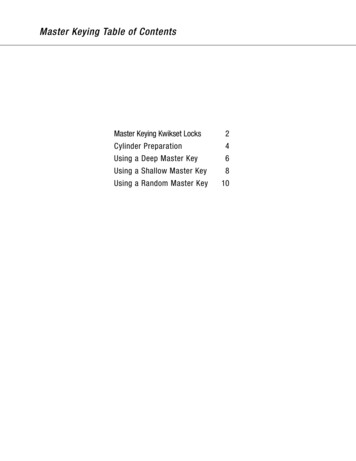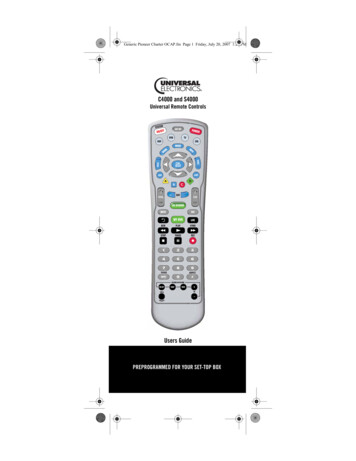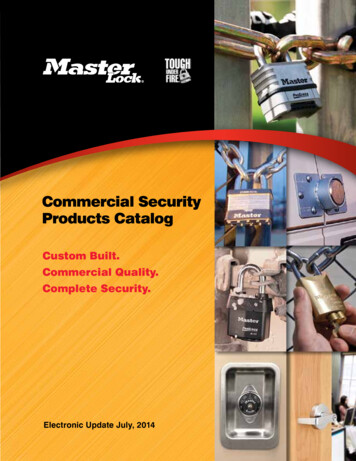
Transcription
Master Key SystemDesign GuideGuidance and worksheets for use with ASSA ABLOY Group brands:ADAMS RITE BARON CECO CORBIN RUSSWIN CURRIES GRAHAM HESMARKAR McKINNEY NORTON RIXSON SARGENT SECURITRON YALE
IntroductionTable of ContentsTo ensure a facility has the desired level of security,it is necessary to have a properly designed andmaintained master key system. ASSA ABLOY DoorSecurity Solutions offers all of the products andservices to help you implement a new master keysystem, or expand an existing one.PlanningKey System ProductsProduct solutions include:Convenience vs. Security,Achieving Proper Balance . . . . . . . . . 3System Structure . . . . . . . . . . . . . 4Levels of Keying . . . . . . . . . . . . . 42-Level System . . . . . . . . . . . . . 53-Level System . . . . . . . . . . . . . 54-Level System . . . . . . . . . . . . . 5 Cylinders for various security requirements levels C ylinders that exceed the stringent standardsset forth by industry testing and listing agencies C ylinders that work with electrified stand-aloneand networked access control systemsProfessional SupportOur team of trained and certified Key SystemSpecialists will help you design a secure masterkey system, develop and implement key controlpolicies, select the right cylinder for eachdoorway, and understand the latest trends inphysical security. As the leader in security andlife-safety solutions, ASSA ABLOY has developedand implemented the industry’s only Key SystemSpecialist Certification Program.Key SymbolsStandard Key Symbols . . . . . . . . . . 62-Level System . . . . . . . . . . . . . 63-Level System . . . . . . . . . . . . . 6Grand Master Pie “A” . . . . . . . . . . . 74-Level System . . . . . . . . . . . . . 8Special Keying Requirements, Larger Systems . . 8System ExpansionDefine Expansion Parameters . . . . . . . . 9Sample Expansion Specification . . . . . . . 9What You Must Know . . . . . . . . . . . 9Theoretical Numbers Reduced . . . . . . . 9Design GuidesMaster Key System Design Guide: In additionto the support provided by our team, this designguide can help you plan and apply a master keysystem. It takes you through the entire processand includes a glossary of master key systemterms and worksheets to assist in the layout phase.Key Control Guide: To extend the life and valueof a key system, proper key control policies mustbe in place. ASSA ABLOY offers a comprehensivekey control guide that will help you design policiesand procedures for your facility.Learn MoreCross Keying . . . . . . . . . . . . . . 10Step by StepDesigning Master Key Systems . . . . .11-12Glossary and Keying LevelsTerms & Definitions . . . . . . . . . . 13-16Levels of Keying . . . . . . . . . . . .17System Design WorksheetSystem Design Worksheet (Level 3) . . . .18Sample System Design Worksheet (Level 3) .19Contact the Key System Specialist of your localASSA ABLOY Door Security Solutions team tolearn more about our products, services andcertification programs, and to get a copy of theKey Control Guide.NOTE: See glossary on pages 13-16 for terms and definitions.For assistance, contact your local ASSA ABLOY Door Security Solutions team.Ask about Key Wizard key control software.
Careful planning is key to the long-term success of a masterkey system. Planning starts with understanding the opposingforces of security and convenience, and creating the properbalance. From there, it’s easy to move onto developing thekey system structure.PlanningPlanningMaximum ConvenienceMaximum SecurityMaximum SecurityMaximum ecurityMinimumPersonalConvenienceSome facilities will be heavily security-oriented. Lack ofconvenience may make it hard to operate the building ona day to day basisMaximumPersonalConvenienceSome facilities will require great personal convenience.This takes away from building security.Opposing ForcesThe cylinder mechanism and the keying system muststrike the right balance between two archrivals—securityand convenience.The type and amount of cross key, the use of keyed alikegroups and the number of levels of keying all play criticalroles in this delicate balance. They also directly affect theamount of expansion available in the system.“Security”“Convenience” SKD sets Extensive cross keying Small, unrelated systems One huge,complicated system Patented keyways Security cylinders High security cylinders Key control Stock keyway Interchangeable core(IC) cylinders Many selective master keys No key controlProper BalanceThe simplest keying systems are often the most secure andwill last longer than complicated ones. Cross keying andcomplicated systems reduce security and expansion potential.NOTE: See glossary on pages 13–16 for terms and definitions.For assistance, contact your local ASSA ABLOY Door Security Solutions team.Ask about Key Wizard key control onvenience3
PlanningPlanningSystem StructureBegin sketching out a key system schematic using descriptiveterms appropriate for the job at hand. Typically these wouldbe departments, buildings or geographic areas. It is notnecessary to account for every change key at this early stage.The schematic often looks like an organizational chart.When planning the system, don’t forget the building core.Core areas are generally maintenance areas: stairwells,mechanical rooms, electrical, phone and HVAC areas.Normally, individual floor or department masters DO NOToperate these areas. Group them all under their own MK(or use changes under the grand, etc.).Key all similar core areas alike: one key symbol for all electricalareas; a second one for all pipe chases; a third for allmechanical rooms, etc. This reduces the need to issuemaster keys to maintenance personnel. Once the structure isdetermined, the next step is to determine the level of keying.SYSTEM WIDEADMINISTRATIONRESEARCHCORE AREASAREASAREASAREASLevels of KeyingFirst, we must understand theconcept of levels of keying. Thinkof it as levels of authority in anorganization. All systems shouldhave a structure like that of acorporate organizational MPLOYEEEMPLOYEEEMPLOYEENOTE: See glossary on pages 13–16 for terms and definitions.For assistance, contact your local ASSA ABLOY Door Security Solutions team.Ask about Key Wizard key control software.
2-Level SystemMKThe simplest master key system has two levels of keyingand is considered the lowest level of master keying. The lesspowerful keys at the bottom are called change keys. Each oneoperates only one lock, or one group of keyed alike locks. Themore powerful key at the top is called the master key.CKCKEven the largest, most complicated keying systems forhospitals and universities can be broken down into piecesthat fit this simple model.CK3-Level SystemGMKA 3-level system is nothing morethan two or more 2-level systemstied together under a higher levelkey called a grand master key.MKMKMKCKCKCKCKCKCKCKCKCK4-Level SystemGGMKA 4-level system ties two or more3-level systems together under ahigher level key called a great grandmaster key.Even though large jobs tend torequire more levels of keying thansmall jobs, most systems do notneed more than 4 levels of keying.In a 4-level master key system, it isespecially important to consider thetraffic flow throughout the KCKCKCKCKCKCKNOTE: See glossary on pages 13–16 for terms and definitions.For assistance, contact your local ASSA ABLOY Door Security Solutions team.Ask about Key Wizard key control software.5
Key SymbolsStandard Key SymbolsKey SymbolsA key symbol is an alpha and/or numeric (A, AA, 1AA)designation that is used to properly identify the correctkey combination for a door or group of doors.2-Level SystemAAHere are a few rules to consider when designinga 2-level system:1AARule #1: Master keys get 2 letters and usuallystart at the beginning of the alphabet. Themaster key shown below is AA.2AARule #2: Change keys have numbers added tothe letters of the master key they’re under. In2-level systems, the numbers come first.3AA3-Level SystemAIn systems with more than 2 levels, the changekey numbers come last. Here we have a 3-levelsystem, a grand master key system.The change key numbers come last and themaster keys have 2 letters. The new item here isthe grand master key.Rule #3: GMKs have only one letter.Rule #4: Masters under the grand must startwith the letter of that grand. All masters undergrand A must begin with the letter A. Avoidthe use of the letters I, O and Q, as they are tooeasily confused with the numbers 1 and 0.AAABACAA1AB1AC1AA2AB2AC2AA3AB3AC3When more than 23 masters are needed undera grand master, insert the rotation numberbetween the letters of the master key symbol.Example: AA through AZ for the first 23 masters,A2A through A2Z for the 24th through the 46thmaster, etc.6NOTE: See glossary on pages 13–16 for terms and definitions.For assistance, contact your local ASSA ABLOY Door Security Solutions team.Ask about Key Wizard key control software.
Key SymbolsGrand Master Pie “A”A keying system is like a pie. You can cut it into many pieces,but the more pieces, the smaller each piece and the morethere is to manage.The larger you make one piece, the less remaining pie available.ARAPASAAABANAMACALADAEAKAJAHAGKey SymbolsKeep It SimpleAAABACADAFFewer masters: preferabledue to more expansionopportunitiesMany masters: “Top heavy”system with limited roomfor expansionThe following represents a schematic of a level three (GMK) system.Your system may vary somewhat from this.AGrand Master Key(HSKP) Housekeeping Key(Selective Master 1SecurityAB1HRAC1 – AC5StorageAA2Lock ShopAB2ITAC6 – AC10Roof AccessAA3Access Control OverrideSKD1Electric ClosetAB3FinanceAC11-AC15Phone ToiletsAD1M-ToiletsAD2FutureAFFuturePlan 30FuturePlan 30A1–President'sOffice(Change underthe Grand)CafeteriaAD3 – AD6JanitorAD7 – AD10Pipe ChasesAB5NOTE: See glossary on pages 13–16 for terms and definitions.For assistance, contact your local ASSA ABLOY Door Security Solutions team.Ask about Key Wizard key control software.7
Key Symbols4-Level SystemGGMIn a 4-level system (great grand master keysystem) the first 4 rules still apply: I t’s a system of more than 2 levels,so the change key numbers come lastABKey Symbols Masters have 2 letters The first letter matches the grandAAABBABBAA1AB1BA1BB1AA2AB2BA2BB2AA3AB3BA3BB3 Grands have a single letterThe new information here is the great grand.Rule #5: The symbol for a great grand masterkey is GGM.Special Keying RequirementsLarger SystemsThere are many other symbols for special keying requirements.Multiplex keyways may be used to accommodate largersystems and expansion requirements necessary for futuredevelopment. Plan your largest systems wisely from the start;with the use of multiplex keyways the bittings are repeated onother key sections. Let the manufacturer decide how to applykeyways to best suit the job at hand based on the numericalexpansion parameters.Selective Master Keys (ENG) Engineering key (HSKP) Housekeeping key (JAN) Janitor’s key (SEC) Security key (GRND) Grounds keyChange Keys Under the Great Grand Master (GGM) GGM1 - The first change key directly under the GGM GGM2 - The second change key directly under the GGM and so onChange Keys Under the Grand Master (GM) A1 - The first change key directly under the GM A2 - The second change key directly under the GM and so on8NOTE: See glossary on pages 13–16 for terms and definitions.For assistance, contact your local ASSA ABLOY Door Security Solutions team.Ask about Key Wizard key control software.
System ExpansionAlways consider the expansion when designing master keysystems. A master key system is like a rubber band. Whenstretched vertically (more levels of keying) it contractshorizontally (fewer combinations at each level). Whenstretched horizontally (more combinations at each level)it contracts vertically (fewer levels of keying are available).Keep this in mind when designing keying systems andsubmitting expansion parameters to the manufacturer.Supply actual numbers for expansion under every masterlevel key, avoid using percentages.Define Expansion Parameters Realistic numbers at each level All branches of system Mixtures of cylinder mechanismsIn many cases, expansion is a guess, but it must be the bestpossible guess. Ask questions like these: How many more buildings in this system? How do future buildings fit into the structure?It’s absolutely critical for the health and longevity of the systemto establish realistic expansion parameters. See sampleexpansion specification section below and note that actualnumbers are shown for each level. W hat is the maximum number of keyed openings perfloor/department/areas that are keyed differently?Define realistic expansion for the number of masters undereach grand, and changes under each master for all parts ofthe system. If different cylinder mechanisms will be mixedon the project, define where each will be used. How do they fit into the overall system? Where does this job fit into the total final system?System Expansion Levels of keyingWhat You Must Know Are future buildings planned? W hat is the maximum conceivable number of keyedopenings on a floor after maximum partitioning? Will all cylinder mechanisms be under the same system?Sample Expansion SpecificationPlanning should include future building additions orpartitions, and rekeying individual door or groups of doorsif change keys or master keys are lost or stolen.Look as far into the future as possible, but don’t “go wild.”Stay realistic, and stay away from percentages.Theoretical Numbers ReducedThe master key system’s overall capacity is affected by thefollowing factors: Mechanical factors of cutting the key Establish a new grand master key system T heoretical numbers are first reduced by amechanical factor, called the MACS (MaximumAdjacent Cut Specification) Plan 20 changes directly under the grand Use of multiple selective keys Plan 10 master keys Cross keyingHere is an example of clear expansion parameters. Plan 50 changes each for each masterNOTE: See glossary on pages 13–16 for terms and definitions.For assistance, contact your local ASSA ABLOY Door Security Solutions team.Ask about Key Wizard key control software.9
System ExpansionCross KeyingCross keying a cylinder allows additional keys other than itsown key set to operate it. There are two types of cross keying:controlled and uncontrolled. See the glossary beginning onpage 13 for additional information.XAA3Cross keying is always designated by the letter “X”: prefix X tothe key symbol, then list each key symbol that is required toalso operate the cylinder. Example: XAA1, OB (operated by)AA2, AA3, AA4, AA, A.AA2Office 1 D oes not fit in a system that has been designedfor securitySystem Expansion Normally results in unplanned key interchange Reduces the overall system capabilities Increases the risk of unauthorized key interchangeConvenience May Reduce Cylinder Security and HinderSystem ExpansionCross keying not only reduces security, it reduces expansionpossibilities. Uncontrolled cross keying (between differentmasters or grands) reduces it even more. If one master is lost,so are all of its changes. If one grand is lost, so are all of itsmasters and all of their changes. This can add up to thousandsof combinations lost. Therefore, supplying extra keys isrecommended rather than jeopardizing the integrity of themaster key system by allowing this convenience.An example of cross keying is when two or more different keyssuch as AA1 and AA2 are both required to operate the samecylinder. This reduces the cylinder’s security. When the crosskeying occurs under all the same higher level keys, such asAA1 and AA2, it is known as controlled cross keying. When itcombines keys under different higher level keys, such as AA1and AB1, it is known as uncontrolled cross keying.In addition to reducing the security of the cylinder, cross keyingusually imposes limits on the flexibility and expansion of theoverall keying system. This is especially true of uncontrolledcross keying. For these reasons, it is strongly recommendedto allow personnel to carry more than one key. Cross keyingshould be discouraged whenever possible. However, whencross keying is required, it is specified below, and should besummarized at the beginning of each order.10AA1Office 2XAA3 operated by AA1, AA2, AA and A.Cross keying: Should be avoidedReceptionistCase #1: Cylinder requires its own XAA3change key. The illustrationReceptionistdepicts part of a small medical building wheretwo doctorsshare a common receptionist. The receptionist gets the AA3key. Each doctor carries a key thatAA2 operatesAA1 only one office,but is also cross keyed into the entrance from the corridor.1Office 2 AA3). ThenDetermine the symbol ofOfficethe changekey (example:prefix the letter X (example: XAA3). Then list all keys that are toXAA3 operated by AA1, AA2, AA and A.operate in an “operated by ” phrase. Example: “XAA3 operatedby AA1, AA2, AA and A”. Note that X is a cylinder specificationonly. The keys for cylinder XAA3 are designated AA3.AA1AA2AA3AA4AA5AA6X1XAA1 by AA1AA2AA3A.X1X operatedthrough AA6, AA andX1XAA4AA5AA6X1X operated by AA1 through AA6, AA and A.Case #2: Cylinder does NOT require its own change key. Thisillustration depicts a section of a floor in a dormitory. Eachstudent’s bedroom key operates the hall door lock. There is noneed to construct a key that operates only the hall door.In this case, place an X at both the beginning and end of thesymbol and a number between them. Example: X1X, X2X,etc. Again, always include the “operated by ” phrase with acomplete listing of key symbols to operate.NOTE: See glossary on pages 13–16 for terms and definitions.For assistance, contact your local ASSA ABLOY Door Security Solutions team.Ask about Key Wizard key control software.
Step by StepDesigning Master Key SystemsStep 1: Meeting Security ObjectivesDetermine the level of access for each opening requiringa cylinder.Here are the different types of cylinder mechanisms. Conventional “open & restricted keyways”- Not contract controlled- Key blanks are readily available Patented locking system- A dministrative documents will be required betweenthe lock manufacturer and owner- Key blank distribution restrictions are in place Security (secondary locking mechanisms)- Provides resistance against picking High security (same as security plus UL437)- Provides resistance against picking and drillingWhen access control devices are furnished with a keyoverride feature special consideration should be givenregarding its keying. Stand-alone access control locking devices (at door wiring) I ntegrated locking systems (hardwired into accesscontrol systems)Step 2: PlanningEstablish the level of the master key system. The higher thelevel, the less secure.Before determining the level ask these very importantquestions: Who, if anyone, is authorized to carry the top master key? Who carries master keys and change keys? Does every employee receive a key?Select the level: Level two – “Simple Master Key System”- C hange key, master key, grand master key, and greatgrand master key L evels higher than four are not recommended forsecurity reasons- With more levels, additional master pins in eachchamber of the cylinder would be required, andwith the additional master pins the possibility ofunauthorized key interchanges could occurSeparate internal departments in the building(s) intodepartments, buildings or geographic areas. Perimeter- Including all exterior doors, roof surfaces, gates andfences, and adjacent buildings Core Areas (Operations)- Sensitive areas crucial to daily operations, such as plantengineering, security and mechanical operations Management- Areas that are vital for daily business activities,including human resources, administration, executiveoffices, IT, and accounting Services- Areas that provide employees and visitors withservices, such as restrooms, medical treatment areas,housekeeping, food service, retail (unless it’s a leasedoutside source)Step by Step- To facilitate multiple users through common doors Level four – “Great Grand Master Key System” Unique Applications- D oor openings requiring access control hardwarewhere key override is required, or any other specialapplication Tenants- Any tenants that are not part of the building I t is recommended to establish a separate system forthose areas requiring security type cylinder mechanismsContinued on next page- Change key and master key only Level three – “Grand Master Key System”- Change key, master key, and grand master keyNOTE: See glossary on pages 13–16 for terms and definitions.For assistance, contact your local ASSA ABLOY Door Security Solutions team.Ask about Key Wizard key control software.11
Step by StepStep 3: Assigning Key SymbolsUse an alpha and/or numeric designation to properly identifythe correct key combination for a door or group of doors. Hereare some helpful hints: Who is authorized to cut keys?- What form of work order will be used to authorizecutting of keys? KISS “Keep It Simple System”- Who will sign the work order? Lowest level possible- What records will be kept, and where? K ey to the building security objectives NOT to theconvenience of the keyholders- Determine if the system is to be designed for securityor convenience (see page 1) Key alike within master key groups as much as possible- A void “top heavy” systems (example: few change keysused under numerous masters) A void cross keying, especially with patented lockingsystems and higher D o not use the term sub-master (unless it’s a level 6system or higher, see glossary for additional informationand correct use of terminology)Step 4: Key Control andKey ManagementStep by Step With whom or where will the key blanks be kept?Establish key hierarchy, key issuing policies and procedures,and administrative disciplines. W hat disciplinary action(s) will be put into placefor violations?- Fines or deposits- Lost keys- Keys not returned- W ill there be a key receipt required? Where will thatbe kept? What is the role of the key control authority?- Authorized to purchase- Responsible for key control administration- Maintains key control software and all transactions Provide adequate quantity of keys- Top master keys - limit the number of these to only a few What type of reports will be required?- Overdue keys- Mis-cut keys- Who receives the reports? O nce a key has been cut, what instructions are givento the recipient?- Key receipt recommended Ensure that all transactions are recorded by the keycontrol authority E NFORCEMENT FROM THE START!Support and back those who are responsiblefor maintaining and servicing the systemStep 5: Service and MaintenanceFollow proper service schedules and procedures.Recommendations include the following: Utilize an in-house or outside locksmith- Ensure proper training- Establish key cutting log- Establish service request procedures Have service equipment available- Key kit- C ode cutter that complies with system’s depths andspacing specifications- Locksmithing tools, fixtures and accessories E stablish stock levels and requirements to avoid misuseof multi-section key blanks- Additional cylinders ready for emergencies- Additional key blanks (of all keyways)- Master keys - also limit the number of these- Change keys per key set and/or per keyed alike sets- S pecial purpose keys; Control keys - limit the numberof these12NOTE: See glossary on pages 13-16 for terms and definitions.For assistance, contact your local ASSA ABLOY Door Security Solutions team.Ask about Key Wizard key control software.
GlossaryThis glossary relates to ASSA ABLOY Door Security Solutionskey systems education and should not be considereduniversal. For a listing of all cylinder, key and master keyingterms, refer to ALOA’s (Associated Locksmiths of America)sponsored publication The Professional Glossary of TermsRelating To Cylinders, Keys, and Master Keying. Permission ishereby granted to reprint terms and definitions from the1991 copyrighted Glossary by the Lock Industry Standardsand Training (LIST) Council with the following stipulations:1. Terms and definitions are to be reprinted in their entirety.2. Credit is to be given to the LIST Council and to the Masterkeying Study Group of the ALOA Sponsored National TaskGroup for Certified Training Programs. Definitions belowthat have been added to ALOA’s publication are noted withan asterisk (*).COMBINATEv. To set a combination in a lock, cylinder, or key.COMPOSITE KEYWAYn. A keyway that has been enlarged to accept more thanone key section, often key sections of more than onemanufacturer.CONSTRUCTION COREn. An interchangeable or removable core designed foruse during the construction phase of a building. Thecores are normally keyed alike and, upon completion ofconstruction, they are to be replaced by the permanentsystem’s cores.ALL – SECTION KEY BLANK*n. The key section that enters all keyways of amultiplex system.CONSTRUCTION MASTER KEY (CMK)n. A key normally used by construction personnel fora temporary period during building construction. Itmay be rendered permanently inoperative withoutdisassembling the cylinder.BITTINGn. 1. The number(s) that represent(s) the dimensionsof the key.CONTROL KEYn. 1. A key whose only purpose is to remove and/or installan interchangeable or removable core.2. The actual cut(s) or combination of a key.2. A bypass key used to operate and/or reset somecombination type locks.BITTING LISTn. A listing of all the key combinations used within a system.The combinations are usually arranged in order of theblind code, direct code, and/or key symbol.BOWn. The portion of the key that serves as a grip or handle.CAMn. 1. A lock or cylinder component that transfers therotational motion of a key or cylinder plug to the boltworks of a lock.2. The bolt of a cam lock.CHANGE KEY*n. 1. A key that operates only one cylinder or one group ofkeyed alike cylinders in a keying system.2. Any device that is used to mechanically orelectronically allow resetting of certain key orcombination locks.For assistance, contact your local ASSA ABLOY Door Security Solutions team.Ask about Key Wizard key control software.CONTROLLED CROSS KEYINGn. A condition in which two or more different keys ofthe same level of keying and under the same higherlevel key(s) operate one cylinder by design: e.g., XAA1operated by AA2. Note: This condition could severely limitthe security of the cylinder and the maximum expansion ofthe system when (1) more than a few of these different keysoperate a cylinder, or (2) more than a few differently crosskeyed cylinders per system are required.COREn. A complete unit, often with a “figure eight” shape, whichusually consists of the plug, shell, tumblers, springs,plug retainer and spring cover(s). It is primarily used inremovable and interchangeable core cylinders and looks.Credential*n. See Change KeyGlossary & Keying LevelsBUMPING*n. One of many methods used to open locks with the use of“bump keys” that leave no sign of physical attack.3. A key that allows disassembly of some removablecylinder locks.CROSS KEYINGn. The deliberate process of combinating a cylinder(usually in a master key system) to two or more differentkeys which would not normally be expected to operateit together. See also “controlled cross keying” and“uncontrolled cross keying.”13
GlossaryCUT KEYn. A key that has been bitted or combinated.DAY KEY*n. 1. The key for a day gate or day operation of a safe orvault lock.2. A cash register key that does not allow audit or resetfunctions.3. See ‘change key’.DISPOSABLE CONSTRUCTION CORE*n. Used with interchangeable core keying, where nonessential locking doors are used within a constructionproject. Locks are supplied with disposable plastic cores.DUMMY CYLINDERn. A non-functional facsimile of a rim or mortise cylinder usedfor appearance only, usually to conceal a cylinder hole.HIGH SECURITY CYLINDERn. A cylinder that offers a greater degree of resistance to anytwo or more of the following: picking, impressioning, keyduplication, drilling or other forms of forcible entry.HOUSINGn. The part of a locking device that is designated to holda core.Glossary & Keying LevelsINTERCHANGEABLE CORE (IC)n. A key removable core that can be used in all or most ofthe core manufacturer’s product line. No tools (otherthan the control key) are required for removal of the core.KEY BITTING ARRAY (KBA)n. A matrix (graphic) display of all possible bittings for changekeys and master keys as related to the top master key.KEY CABINET*n. A cabinet with hooks, Velcro, or other means designed tostore keys systematically.KEY CHANGES*n. The total possible number of different keys available for agiven type of tumbler mechanism.KEY CONTROLn. 1. Any method or procedure that limits unauthorizedacquisition of a key and/or controls distribution ofauthorized keys.KEY INTERCHANGEn. An undesirable condition, usually in a master key system,whereby a key unintentionally operates a cylinder or lock.KEY SECTIONn. The exact cross sectional configuration of a key blade asviewed from the bow toward the tip.KEY SYMBOLn. A designation used for a key combination in the standardkey coding system, e.g., A, AA, AA1, etc.KEY SYSTEM SCHEMATIC
The simplest master key system has two levels of keying and is considered the lowest level of master keying. The less powerful keys at the bottom are called change keys. Each one operates only one lock, or one group of keyed alike locks. The more powerful key at the top is called the master key. Even the largest, most complicated keying systems for










